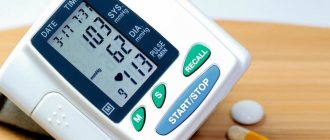What is heart rate in swimming, why does a swimmer need to train his pulse zones, what training is needed for sprinters and what for stayers - the master of sports in swimming at distances of 100 and 200 meters freestyle, butterfly and 200 meters medley swimming, champion and medalist talks about all this Ukrainian swimming championships, coach of the Novgorodtri triathlon club Vladislav Dubovoy.
Read on the topic: Pulse zones: what heart rate to run at
What is heart rate in swimming?
HR – heart rate. The difference between heart rate and pulse lies in the terms themselves: heart rate demonstrates the number of contractions of the lower ventricles per minute; the concept of “pulse” considers the number of arterial dilations at the moments when the heart ejects blood in 60 seconds.
Although these two concepts are completely different, it is considered an absolute norm when heart rate and pulse indicators coincide. But this is not always the case.
For an athlete who engages in swimming, like any other cyclic sport, the heart rate zone depends on the type of training and the degree of load.
For example, warm-up is done in the first, easy, zone. And training for sprint swimmers takes place in the fourth and fifth zones, but for a short time. Stayers try to keep their training in the third zone, and it is in this zone that they carry out the greatest amount of their work.
You need to understand that there is a big difference in the heart rate limits between professional athletes and amateurs. Athletes who train daily and do high volumes will have a significantly lower resting heart rate. Also, professionals will recover faster than amateurs from intense exercise and high-speed work.
Therefore, before you start training, it is important to determine your level and heart rate capabilities from a sports doctor. Only after this can you start training.
marathon and half marathon training plans and start training today! -30% with promo code PLAN2020 all December!
Causes of bradycardia in athletes
Although physiological bradycardia in athletes is often associated with increased parasympathetic tone, recent research suggests that it may result from remodeling of pacemaker ion channels and resetting of the intrinsic heart rate.
In most people, this condition is asymptomatic, and bradycardia in athletes is considered normal. However, these patients are at risk for bradycardia-related problems such as dizziness or fainting later in life.
Paradoxically, the most life-threatening complication of bradycardia on the ECG in athletes can be seen as ventricular tachycardia, caused by one or more ectopic ventricular foci disrupting the rhythm of the bradycardic sinus.
Recent studies estimate that the cutoff for bradycardia in trained athletes among 60 former professional cyclists with an average age of 66 years was approximately 50 percent.
Pacemaker placement is the definitive treatment for symptomatic bradycardia in former athletes. The prevalence of pacemaker insertion is increasing in Western countries as the population ages, with approximately 12% of these insertions being associated with sinoatrial causes of severe bradycardia in athletes. Because the rate of pacemaker insertion in older athletes is at least three times higher than in matched controls, this rate may continue to increase as people age.
How to calculate your maximum heart rate (MHR)
There is a formula for calculating MHR: 220 – age. For example, an athlete who is 30 years old will have an MHR of 190 beats per minute. But this is only a generally accepted formula, so it is better to undergo laboratory testing to obtain accurate data about the capabilities of the heart.
The two most well-known testing methods are exercise tests on a treadmill (on a treadmill) and on a bicycle ergometer (on an exercise bike). A sports doctor will comment on the data obtained.
Read more on the topic: How to calculate maximum heart rate (MHR)
Calculation of MHR (maximum heart rate)
Previously, the average formula for determining the MHR was used: 220 - the number of years. That is, if you are 45 years old, then the MHR is 175 beats/min. At the moment, there are already refined formulas for men and women, but even they do not give such accurate results as laboratory testing. It is this that allows you to accurately determine the parameters of your heart.
Most often, MHR is determined either using a stress test on a treadmill (treadmill) or using a special exercise bike (bicycle ergometer). Based on the results of the research, the doctor will calculate your pulse zones.
What should your heart rate be when swimming?
For a professional swimmer, the heart rate depends on the type of training and the tasks that the athlete must complete. If we are talking about an amateur or a novice swimmer whose level of physical fitness is still low, then, accordingly, the loads should be in the 1-3 pulse zone and increase gradually.
Long distances require swimmers to work in the 2nd and 3rd zones. In order to calculate the required heart rate for this distance, you need to know your MHR and swim at a heart rate of 70-80% of the maximum. For example, if the MHR is 190 beats per minute, then you need to swim long distances at a heart rate of 160-165 beats per minute.
You can't go such a long distance at a higher heart rate. Such distances, as a rule, begin from the 2nd pulse zone, gradually increasing the speed, maintaining the desired heart rate indicators.
The first kilometer is always the slowest, the start of the distance cannot be fast, then the speed increases, and you need to endure work in the 3rd pulse zone. An athlete’s last meters are usually the most explosive in terms of speed.
Why do professional athletes often have bradycardia?
A low, regular heart rate in athletes is called "athlete's heart syndrome." It is often recorded in professional athletes, as well as in people who engage in sports for a long time (more than an hour a day). This is how the body adapts to stress. Despite its “physiological” nature, this condition can mask serious health problems.
In adolescent athletes, bradycardia is often associated with changes in the cardiovascular system and also requires monitoring.
Most often, bradyarrhythmia is a consequence of active (more than 5 hours per week) aerobic exercise; less often it occurs when performing static exercises, for example, when lifting weights. During intense, long-term exercise, the heart pumps more blood to meet the increased oxygen demands of skeletal muscles. The chambers stretch, the wall increases in size. As a result, cardiomegaly (enlargement of the heart) and, in particular, left ventricular hypertrophy develop.
Is there a difference between heart rate zones in open water and in a pool?
Open water - sea, river or any other body of water - requires long distances, including marathons. Swimming in a pool ranges from 50 to 1500 meters. Hence the difference in pulse zones.
Read on the topic: The benefits of swimming: 20 reasons to go to the pool
Sprinters swim short distances in the pool in the 4th and 5th pulse zones. And professional athletes, swimming such a distance in crawl, for example, in 22 seconds, practically do not breathe, and their heart rate reaches about 95-100% of heart ratemax. The swimmer will cover the marathon distance of 6 km in the sea, working in the 2nd and 3rd pulse zones.
Over long distances in open water, the athlete maintains a monotonous regime, performing the task of maintaining the work of his heart in a given pulse zone and saving energy to overcome the entire distance.
However, in open water, the pulse over a long distance will still be slightly higher than in the pool, since additional resistance to the athlete can be created by equipment or natural conditions: wind and current.
What does heart rate mean during swimming training?
The term HR stands for “heart rate.” Many people confuse heart rate with pulse, although these metrics differ in the very principle of their definition. Heart rate is the number of heartbeats over a certain period of time, most often per minute. The pulse characterizes the movement of blood through the vessels, that is, how many times per minute the arteries expand under the influence of blood flow from the heart.
These terms are often confused because normally their meanings should be the same. But there are other options.
Swimmers (as well as runners, cyclists and other cycling athletes) know that heart rate can vary depending on the type of activity and level of load.
Everyone warms up, as a rule, within the first zone. Long-distance swimmers strive to maintain their heart rate in the third zone, this ensures endurance. But the intense training of sprinters moves to the fourth and fifth zones. This is where the highest results are shown.
Please note that heart rate ranges will vary depending on your fitness level. The more often and longer your exercise, the lower your resting heart rate will be. Athletes who exercise regularly will also find it easier and faster to recover from high-intensity, high-speed activities.
Therefore, you should always start active exercises after consulting a doctor (preferably a sports doctor), who, among other things, will calculate your standard heart rate level.
How to train pulse zones
Each heart rate zone has its own type of workout.
- The first zone is not considered a training zone; this is the pulse with which we walk, talk, and carry out current affairs.
- The second zone is also not trained, but swimming techniques are practiced in it: calm, effortless crawl, breaststroke, calm backstroke. There should be no shortness of breath when swimming in this area.
- The third zone is trained in a series of longer segments, for example, 4 times 400 meters with a rest of about 40-50% of the swimming time. If you swim 400 meters in 6 minutes, then rest between series should be 2 minutes. And shortness of breath should go away within 30 seconds, then the pulse will return to the first zone.
- Zone 4 is trained in shorter segments than Zone 3 workouts, but at higher intensity and with less rest time in between. For example, 20 times 100 meters. For an amateur who swims 100 meters freestyle in 1 minute 30 seconds, rest should be no more than 1 minute between segments.
The specificity of this zone is that you cannot train in it every day. If the training schedule includes 5 days a week, then a day of intense training in the 4th zone must be followed by a day of work in the 2nd or 3rd zone.
Effective training: keep your finger on the pulse
Pulse is the most important indicator of a person’s condition during exercise. It shows how correctly you are training, whether you need to increase your activity or, on the contrary, slow down. There are different training goals, and depending on them, you need to choose the appropriate “heart rate zone”. First you need to calculate your maximum heart rate. Let's call this characteristic briefly - MP (maximum heart rate). It is calculated using a simple formula: 220 - (your age). That is, for a person who is 33 years old, the MP is 220 - 33 = 187. So, let's move on. Now you need to determine what your heart rate should be during training. There are several “pulse zones”: 1) “Warm-up zone” is in the area of 55-65% of MP. It doesn't take a genius to understand that you need to warm up in this zone. But, in addition, such a pulse is suitable for therapeutic training for the development of the cardiovascular system. In addition, the “warm-up zone” of the pulse is an excellent hangover reliever! 2) “Fat burning zone” is 65-70%. The smartest people have probably already realized that this zone is ideal if you are interested in swimming for weight loss. After all, when the pulse is in the range of 65-70% of MP, 85% of fats, 10% of carbohydrates and 5% of proteins are burned. The higher we raise our heart rate, the less fat will be burned and the more carbohydrates will be burned. Those who go to the pool for health and beauty should train in this zone. 3) Aerobic zone - 70-80%. This is where the endurance work begins. Fat continues to be burned quite actively. During such work, the body spends approximately 50% carbohydrates, 49% fats and 1% proteins. If your goal is to increase endurance, you should work in this zone. Area for long and medium distance swimmers. 4) Anaerobic zone - 80-90%. In this range, muscle mass develops and strength increases. The body requires more and more carbohydrates - 85%. Fat is practically not burned - 14%. Well, 1% remains for protein. The zone is ideal for those who swim short distances and who value explosive speed. 5) MP zone - from 90% to 100%. It is used rarely and mainly by trained athletes to achieve their maximum. Oddly enough, this zone is also good for weight loss - it is with its help that interval training is carried out. These are sessions during which your heart rate jumps greatly - from the MP zone to the “warm-up” or “fat burning zone”. Such training increases metabolism. The effect can last up to two days - during this time you will burn fat. For example, let’s calculate the “fat burning zone” for our 33-year-old man. To do this, we multiply his MP (187) by 0.65 - we get 122, and then MP (187) * 0.7 = 131. This means that his “fat burning zone” will be in the range from 122 to 131. The remaining zones are easily calculated in a similar way. So, we figured out the basic principles of working with pulse. All that remains is to determine it, this pulse. To determine your heart rate during swimming (and sports in general), Proswim.ru recommends a special device: the Aquapulse heart rate monitor from Finis. This device has no analogues in the world in terms of ease of use. Unlike most heart rate monitors, it measures your heart rate without any chest straps that create discomfort during exercise. Instead, the compact meter clips onto your glasses strap or cap next to your ear. The second part clings to your earlobe - it is the one that reads your pulse data. She does this using an infrared sensor that reads the movement of blood through the capillaries. Here you may have a completely reasonable question: “The infrared sensor, capillaries - it’s all cool. But where can I look for a pulse?” And you don’t need to watch it anywhere! The device itself will tell you your pulse through bone transmission of sound directly into the inner ear. No headphones are required for this. You can customize the frequency of heart rate messages yourself. Well, isn't it fantastic? No uncomfortable belts, and no need to be distracted or look somewhere to find out your pulse! People who have dealt with traditional heart rate monitors will definitely appreciate these properties. Interested? Let's take a closer look at this unique device. Let's start with the configuration:
I think everyone knows what to do with the instructions and USB cable. Therefore, let's move straight to the description of the device. Take a closer look: this clothespin will read our pulse from our earlobe. Don't worry, it won't hurt :)
The device's USB port is hidden under a protective cap. It is needed to replenish the charge of the heart rate monitor. The cap is needed primarily to protect against mechanical damage, since the port is protected from water.
Let's look at the device settings.
We have options here: 1) Change the alert volume. 2) Change the notification frequency. That's all, have a look! There are no more settings. In fact, this is one of the simplest electronic devices for sports. And these two functions are thought out to the smallest detail! For example, every time you change the volume, the heart rate monitor will greet you warmly: “Hello!” This way you will know whether the volume level is appropriate or not. To change the volume, you need to quickly press one of the arrow buttons once, and to select a different alert frequency, you need to press and hold one of the same buttons. That's the whole difference. When you change the alert frequency, the device will tell you the new interval. The following intervals are available: 10s, 20s, 30s, 45s, 1m, 2m, 5m. In addition, an instant notification button is provided for convenience. If you click on it, you will immediately hear information about your heart rate, regardless of the alert interval. Everything is very clear with the settings; it couldn’t be simpler. Let's move on to swimming with the device.
This is how the device is attached to the glasses strap. You can also attach it to a hat. Then you need to attach the clothespin to your earlobe and turn on the device.
That's it, you can swim! The device is clearly audible both underwater and above it. In this regard, I think it can be successfully used for other sports. Ideal for triathlon! You can measure your heart rate during swimming, running and cycling. When informing you about your heart rate, the device reports the average value from the last three calculations. That is, the data of the last few seconds. It turns out that even if you choose an interval of two minutes, the heart rate monitor will not report the average result for these two minutes, but the average for the last few seconds. And so on at any interval. This is very useful as you get up-to-date data at a specific point in time.
So, if you are going to measure your pulse in the pool during training, you will not find a better option than Finis Aquapulse. In addition, the device is suitable for activities on land. But Finis still has room to improve! There are a couple of points that can be improved: 1) The heart rate monitor does not float on the surface of the water, that is, it can drown. Of course, the fastening is very reliable and it is unlikely that it will come off during a swim, but it still wouldn’t hurt to add some buoyancy. 2) I would like the device to be able to store various data, such as the average heart rate for a workout, the highest and lowest heart rate. This would help to see the big picture after training. But these are minor omissions that do not spoil the impression of the device at all. After all, there are much more positive aspects: 1) Accurate data on the pulse 2) Very easy to use 3) No belts around the torso are needed 4) No need to look anywhere or be distracted to find out the pulse 5) The volume and alert interval are easily and clearly adjusted 6) Compactness 7) Can be used for training on land The battery lasts 5-8 hours - more than enough for a good swim And finally, I would like to tell a short and instructive story about this heart rate monitor. Finis Aquapulse appeared in 2012, although the company announced its appearance two years before that. Why did the release take so long? The final pre-production test recorded a small error of 5%. That is, the pulse data was 95% correct. Unlike many companies, Finis decided to postpone the release indefinitely - until engineers can overcome this error and bring it exactly to 100%. Even though it took about two years to achieve this, the company patiently waited for this 100%. A great example for all of us, right?
In addition, the device is suitable for activities on land. But Finis still has room to improve! There are a couple of points that can be improved: 1) The heart rate monitor does not float on the surface of the water, that is, it can drown. Of course, the fastening is very reliable and it is unlikely that it will come off during a swim, but it still wouldn’t hurt to add some buoyancy. 2) I would like the device to be able to store various data, such as the average heart rate for a workout, the highest and lowest heart rate. This would help to see the big picture after training. But these are minor omissions that do not spoil the impression of the device at all. After all, there are much more positive aspects: 1) Accurate data on the pulse 2) Very easy to use 3) No belts around the torso are needed 4) No need to look anywhere or be distracted to find out the pulse 5) The volume and alert interval are easily and clearly adjusted 6) Compactness 7) Can be used for training on land The battery lasts 5-8 hours - more than enough for a good swim And finally, I would like to tell a short and instructive story about this heart rate monitor. Finis Aquapulse appeared in 2012, although the company announced its appearance two years before that. Why did the release take so long? The final pre-production test recorded a small error of 5%. That is, the pulse data was 95% correct. Unlike many companies, Finis decided to postpone the release indefinitely - until engineers can overcome this error and bring it exactly to 100%. Even though it took about two years to achieve this, the company patiently waited for this 100%. A great example for all of us, right?
Why do swimmers need pulse training?
In amateur swimming and long-distance swimming, it is not necessary for stayers to work in maximum heart rate zones, but they still need to be done from time to time. These works must be performed under the supervision of a trainer.
Such training is necessary so that the body is prepared for the finishing spurt at the end of the distance, where stayers have to swim in the fifth pulse zone.
Stayers need to work in the fourth pulse zone in order to make turns in the pool or turns around a buoy in open water without losing speed. Working in this zone on 100-meter segments trains stayers' endurance.
Why does a swimmer need heart rate training?
There may be an opinion that training in zones 4 and 5 is only for sprinters or professionals. This is wrong. Learning to work at the maximum heart rate values is useful for both amateurs and stayers. But such classes must be led by a trainer.
How are such activities useful? They prepare the body for the finishing spurt, where the maximum heart rate will be required from the stayer.
Also, classes in the 4th zone allow stayers to practice turns and turns on buoys without reducing speed. Training in this range in 100-meter heats increases the endurance of stayers.
How to measure your pulse correctly in water
Now there are many gadgets that measure pulse in water. A watch that reads your pulse from your wrist using an electro-optical sensor is quite suitable for this.
Traditional chest heart rate monitors in water will be of little information, since the sensor does not have close contact with the chest, and the information may be incorrect.
You can use the well-known method: place your fingers on the carotid artery, count the number of beats for 10 seconds, multiply the resulting figure by 6. The result will be the actual pulse.
How many times a week is it optimal for amateur swimmers to train?
If a person is just starting to learn swimming, then two or three training sessions a week under the guidance of an experienced coach will be enough. These workouts should include a swimming foundation: slow swimming in the 2nd pulse zone, working on technique with the gradual introduction of different types of work on the water.
There is no point in increasing the number of workouts per week at this stage: the body must prepare for the stress and be able to recover.
For those amateurs who know how to swim and are preparing for some kind of competition, for example, a triathlon, it is recommended to train 3-4 times a week. In this case, there should be a weekly or monthly training plan, including different types of exercise in the water.
Read on: How to choose a wetsuit for triathlon and open water swimming
How often should amateurs train?
If you have just started learning to swim, 2-3 lessons a week with a coach will be enough for you. In these classes, you gain basic knowledge and practice basic skills: swimming without acceleration in the second pulse zone, practicing various swimming techniques.
There is no need to practice more often at this stage. The body needs time to recover and prepare for further stress.
If you have already mastered swimming and are preparing for some competition (including triathlon), it is better to increase the number of training sessions to 3-4 per week. It is also recommended to create a training plan for a week or month, indicating different types of load.
Heart Rate Training Recommendations for Swimmers
- Beginner (amateur) and professional swimmers must do a warm-up on land before training in the water to prevent injuries.
- Warm-up directly in water is intended to prepare the body for long-term exercise; it should take place in the second pulse zone.
- Beginning swimmers should definitely alternate training days with rest days. The optimal amount is 3-4 workouts per week.
- A cool-down (purchase) in water after a high-intensity workout (in the 4th zone) should take place in the green pulse zone and be at least 10% of the total workout volume.
- For beginner swimmers, technique training should be performed in the 2nd and 3rd pulse zones (depending on the complexity of the exercise). And they need to be done at least once a week.
- When preparing for long distances, if more intense training is not enough, you can include work in the anaerobic pulse zone in the training plan. And don't forget about recovery!
- Regular heart rate monitoring will help track recovery and prevent overtraining, which will allow you to control the load and frequency of training.
Read further: Cramps when swimming: why your legs cramp and how to deal with it











